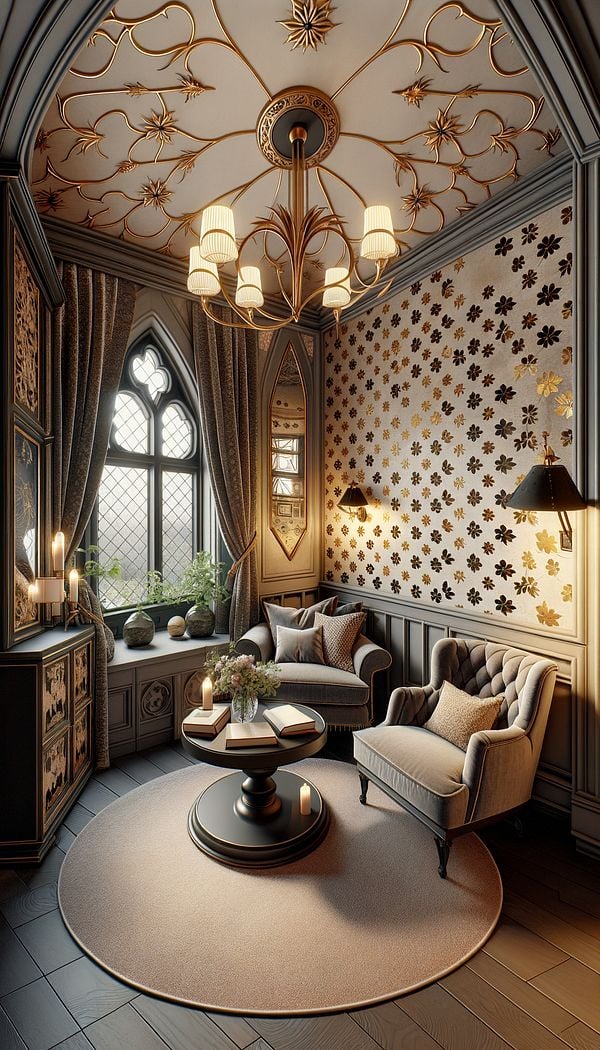What is a Cinquefoil?
Cinquefoil is an architectural motif used primarily in Gothic architecture.
Description
Cinquefoil, derived from the French words "cinq" (five) and "feuille" (leaf), refers to an architectural motif featuring a design that resembles a five-leafed clover. It is a form of ornamental detail commonly seen in the decorative tracery of Gothic architecture. This motif is especially prominent in the design of windows, archways, and panelling, displaying intricate shapes that create a visually appealing aesthetic. In interior design, the use of cinquefoil shapes can add a historical or Gothic-inspired touch to the decor, influencing the design of furniture, window treatments, and decorative objects.
The presence of cinquefoil in a space can evoke a timeless elegance and a connection to medieval design principles. The motif's inherent symmetry and geometric beauty contribute to its use in creating harmonious and balanced interior spaces. Cinquefoil is not only an example of the remarkable craftsmanship of the past but also serves as an inspiration for contemporary design, blending historical aesthetics with modern styles. By incorporating cinquefoil motifs, designers can bridge the gap between traditional and contemporary interior design, thereby achieving a unique and timeless ambiance.
Usage
In contemporary interior design, cinquefoil motifs are often incorporated into various elements, such as wallpaper patterns, fabric designs, and decorative accents like mirrors or wall art. These motifs can also be seen in the detailing of Gothic revival furniture pieces or in the design of bespoke light fixtures that mimic the intricate tracery seen in Gothic architecture.
FAQs
-
Is cinquefoil exclusive to Gothic architecture?
While cinquefoil is most commonly associated with Gothic architecture, its geometric and aesthetic appeal allows it to be adapted for various design styles beyond its traditional context.
-
Can cinquefoil motifs be used in modern interior design?
Yes, cinquefoil motifs can be seamlessly integrated into modern interior design, adding a historical nuance or a touch of elegance to contemporary spaces.
-
How are cinquefoil motifs commonly used in interior design today?
Today, cinquefoil motifs find application in wallpaper designs, fabric patterns, and decorative accents, as well as in the detailing of furniture and light fixtures.
Practical Application
When incorporating cinquefoil motifs into your design project, consider their origins and the traditional context to ensure they align with the overall design theme. Use these motifs sparingly for highlights or focal points to lend an air of sophistication and historical depth to the space. Matching the cinquefoil's intricate patterns with simpler designs can create a balance, making the space more visually appealing and cohesive. Keep in mind the scale of the cinquefoil design in relation to the room to maintain a harmonious and proportional aesthetic.
-
Architectural Elements199 articles
-
Design Styles478 articles
-
Decorative Objects240 articles
-
Historical Periods & Movements150 articles
-
Wall Treatments & Finishes157 articles
-
MoiréMoiré is a unique visual phenomenon produced by the superimposition of two or more sets of fine patterns or grids.
-
MonochromeMonochrome refers to a design theme that uses different shades, tones, and textures of a single color.
-
Open PlanOpen plan refers to a floor layout without walls or barriers between different living spaces.
-
BrocadeBrocade is a rich, decorative fabric often woven with a raised pattern.
-
InlayAn inlay is a decorative technique that involves embedding pieces of one material into another to create patterns or designs.
